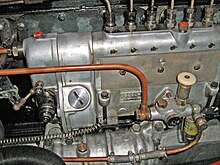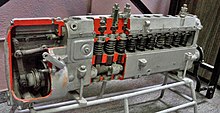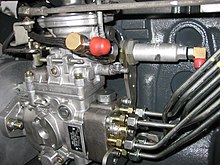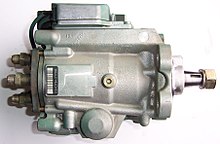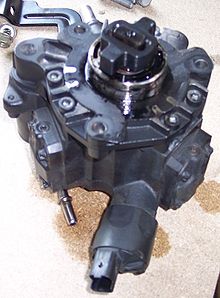Injection pump
An injection pump is a metering pump for high pressure and is part of the injection system in internal combustion engines . The injection pump provides a defined amount of fuel per stroke with the necessary pressure ( injection pressure ) to deliver fuel through the injection valve into the combustion chamber or the intake pipe. It is required in diesel engines to inject diesel fuel and has been increasingly replaced by common rail systems since the turn of the millennium . Since the 1930s, injection pumps have also been used in gasoline engines instead of carburettors .
Gas turbines and rockets operated with liquid fuels also require defined amounts of fuel, sometimes at high pressure. The pumps used are not referred to as injection pumps.
scope of application
Injection pumps are widespread in diesel engines, diesel engines without an injection pump (engines with air injection ) became obsolete at the beginning of the 20th century; Today there are no longer any diesel engines without an injection pump, as the injection pump is required for high-pressure injection of the fuel into the combustion chamber. Because of the high pressures, the compressibility of the fuels is no longer negligible, as is the reversible longitudinal and transverse expansion of the metal pipes when pressurized, so that the vibrations of the fuel columns in the injection lines must be taken into account when designing the diesel injection system. For this reason, for the sake of simplicity, the injection lines are designed to have the same length for each cylinder.
Injection systems had also been in use for passenger car gasoline engines since the early 1950s. The first production cars with mechanical direct fuel injection were the Gutbrod Superior and the GP 700 E , both of which came onto the market in 1951 with two-stroke engines. A short time later, the Mercedes-Benz 300 SL (" Gullwing ", 1954) appeared - with four-stroke engines - and the following year the 300 Coupé / Cabriolet ( W 188 ). Towards the end of the 1950s, engines with manifold injection emerged , as direct injection caused problems with oil dilution and the complex injection pump was very expensive to manufacture. Since the 1970s, electronically controlled intake manifold injection with an electrically driven feed pump, in which the fuel is metered using variable injection pressure or variable injection duration, has been gaining ground.
function
The task of the injection pump is to meter the fuel precisely, to inject it at the right time and for the right time. In addition, the control of the injection pump should adjust the fuel delivery depending on the engine speed and operating temperature.
The injection pump as a unit thus has several tasks. On the one hand, it is used for the pure transport of fuel from the fuel tank to the engine. For this purpose, it has a fuel pump , which usually runs at the same speed as the internal combustion engine. In the case of fuel pumps without volume regulation, the amount of fuel delivered follows the engine speed. Since the amount delivered is higher than the actual requirement, the excess is returned to the fuel tank via a separate return line. In this way, excessive, local heating in parts of the injection pump as a result of the inevitable friction can be reduced. In addition, the fuel filter and the tank are heated by the return.
Furthermore, the pump has at least one further controlled high-pressure pump which determines both the time and the amount of the actual fuel injection.
Various pump systems are used to build up the injection pressures in the above processes:
- Single injection pump
- Distributor injection pump or
- In-line injection pump
Basics of the structure
Injection pumps are piston machines that deliver discontinuously. The pressure build-up takes place via a linear piston movement. The energy for the printing process is taken in a rotary manner by a motor-driven camshaft that is firmly coupled to the crankshaft in the transmission ratio and transferred to the piston or pistons. The conversion of the rotation to the translation of the piston does not take place via a crank drive (by means of a connecting rod and piston pin) guided for back and forth movement, but via direct pressure generation under friction. Thus, the kinematics of in-line injection pumps in particular resembles the valve train via camshaft and bucket tappets on the inlet and outlet valves of a reciprocating piston engine.
Types of injection pumps for diesel engines
In the following designs, the piston plays a central role as a pump and metering element. The type of pump used is also influenced by the engine design, so for commercial vehicles and industrial engines with individually built cylinders, the pumps can also be designed individually (single piston pump, pump-nozzle) in order to facilitate maintenance and repair or, in an emergency, to replace the engine with fewer cylinders to operate (e.g. on the high seas).
In-line injection pump
In an in-line injection pump, the individual pump elements assigned to the respective cylinders are combined in a housing or are arranged as modular individual pumps next to one another on a drive shaft. The in-line injection pump has controls for the speed , the injection quantity and the injection timing (injection adjuster). The individual pump elements are built as reciprocating piston pumps and their bore and stroke (depending on type and operation) cannot be changed. In order to achieve variable dosing, the pistons are designed to be rotatable about their axis of symmetry. They can be rotated simultaneously via a rack during operation. The cylinder jacket of the pump piston is provided with one or two helical millings, which - earlier or later, depending on the rotational position of the piston - passes over and closes the inlet bore in the pump cylinder wall. The closure of the inlet bore is the start of delivery of the pump element. If the lower control edge passes over the inlet bore, the injection is ended. The radial piston pump is a modification of the in-line injection pump. The in-line injection pump requires external lubrication, either through a connection to the engine oil circuit or its own oil sump. Due to the separation of lubrication and pumped fuel, in-line injection pumps are more robust than distributor injection pumps in terms of wear, but also in terms of fuels with poorer lubricating properties such as kerosene or gasoline in multi-fuel engines . Diesel injection systems with in-line injection pumps have largely been replaced in modern diesel engines by common rail , pump-line-nozzle or pump-nozzle systems.
Distributor injection pump
The distributor injection pump is driven by the motor via a shaft, and with it the prefeed pump installed in the pump housing, usually a vane pump . This draws the fuel in from the fuel tank and pumps it into the interior of the pump. The fuel pressure inside the injection pump is regulated by a pressure control valve. This is followed by the high-pressure part of the pump, which generates the injection pressure.
There is only one pump element that supplies the individual cylinders through a downstream distributor. The number of strokes of the pump element is calculated from half the engine speed, multiplied by the number of cylinders (for a four-stroke engine ). Here, too, the injection quantity and the injection time are regulated; the control variables are load and speed. A distributor injection pump is much cheaper to manufacture than an in-line injection pump, and the external dimensions are more compact.
It does not require a supply of lubricating oil through the engine oil. The moving parts of the distributor injection pump are lubricated by the fuel, which is why it must have lubricating properties. The distributor injection pump is more sensitive to differences in viscosity of different fuels at different temperatures, e.g. B. vegetable oil and diesel fuel or biodiesel (summer and winter). Due to the significantly higher number of strokes, the pump piston is mechanically more heavily loaded than the pump elements in the in-line injection pump. In the event of a defect on the distributor pump piston, the diesel engine is out of operation, while with in-line injection pumps, it may still be possible to continue driving with a single defective pump element on the remaining cylinders.
Distributor injection pumps can be designed as axial or radial piston pumps. The latter can generate maximum pressures of up to 1950 bar. As a rule, it generates a delivery pressure of 3 to 8 bar, which is limited to max. 12 bar is limited. An electronic diesel control EDC is possible, which on the one hand enables greater precision of the controls and on the other hand makes it impossible to operate the engine without a power supply. The last distributor pumps had integrated pump control devices, some of which contained the functions of an EDC.
The drive shaft has camshaft speed and in the axial piston pump sets the lifting disc and the distributor piston in rotary motion. The lifting disc has cams that slide over the rollers of the roller ring. As a result, the distributor piston connected to the lifting disk performs a rotary-lifting movement. As soon as the inlet channel to the high pressure chamber is closed, the fuel is compressed by the lifting movement. As the piston continues to rotate, an outlet bore to an injection nozzle is opened and the fuel is pressed through a pressure valve to the nozzle and it is injected into the combustion chamber .
In the radial piston pump, the pressure is no longer generated by a stroke movement of the distributor piston, but by radial pump elements that are actuated by the rotary movement of the distributor piston. This design is more complex than an axial piston pump, but enables higher injection pressures.
Since the beginning of the 2000s, diesel injections with distributor injection pumps have largely been replaced by common rail systems in passenger car construction .
Single ram pump
This corresponds to the in-line injection pump, each cylinder is controlled by its own pump; it is driven by the camshaft.
Such pumps are also known as plug-in pumps, especially in truck diesel engines with a camshaft below . These are used z. B. Mercedes-Benz engines of the 900 or 500 series. With the plug-in pump, pressures of up to 1850 bar and double injection are achieved.
Pump nozzle
In the pump-nozzle system , the single piston pump is combined with the injection nozzle . This reduces the disruptive influences of the fuel pressure lines on the system. The control of the pump element used to be done mechanically, nowadays the injection duration is controlled by a piezo or magnetic valve. When open, these valves connect the pressure channel and return. This causes the pressure to collapse and the injection nozzle to close. However, the injection pressure is heavily dependent on the speed of the driving camshafts and cannot be regulated.
High pressure pump for common rail
The high pressure pump that generates the diesel high pressure in common rail systems can also be referred to as an injection pump. The common rail pump, however, is only regulated with regard to the pressure, but not for quantity and timing regulation of the cylinder injection as in other injection pump systems; These control functions are carried out outside the pump in an electronic control system and by means of the injection valves controlled by the latter. Various methods are used to ensure the required pressure and the required volume flow. Either a pressure control, a control via the supplied or compressed fuel volume or a combination of these variants is used. Since common rail pumps work with pressures of up to 3,000 bar, the mechanical forces inside the pumps are high. In addition, there are increasing fuel temperatures , which reduce the lubricity of diesel fuel. Since the pumps are lubricated by the diesel fuel itself, mainly for cost reasons, the bearings and sliding surfaces are tribologically heavily loaded due to the limited lubricating effect and seizure can only be avoided with considerable effort . For this reason, an unknown number of diesel drivers add certain completely and soot-free burning two-stroke oils in a ratio of 1: 200 to the diesel as a "lubricating reserve".
literature
- Richard van Basshuysen, Fred Schäfer: Handbook Internal Combustion Engine Basics, Components, Systems, Perspectives. 3rd edition, Friedrich Vieweg & Sohn Verlag / GWV Fachverlage GmbH, Wiesbaden, 2005, ISBN 3-528-23933-6
- Hans Jörg Leyhausen: The master craftsman's examination in the automotive trade part 1. 12 edition, Vogel Buchverlag, Würzburg, 1991, ISBN 3-8023-0857-3
- Max Bohner, Richard Fischer, Rolf Gscheidle: Expertise in automotive technology. 27th edition, Verlag Europa-Lehrmittel, Haan-Gruiten, 2001, ISBN 3-8085-2067-1
- Klaus D Linsmeier, Achim Greis: Electromagnetic actuators. Physical principles, designs, applications. In: Die Bibliothek der Technik, Volume 197. Verlag Moderne Industrie, ISBN 3-478-93224-6
- Explanation and source for the common rail high pressure pump
Individual evidence
- ↑ Bosch: Solenoid valve controlled radial piston pump distributor pump VP44-S5, brochure, 1999
